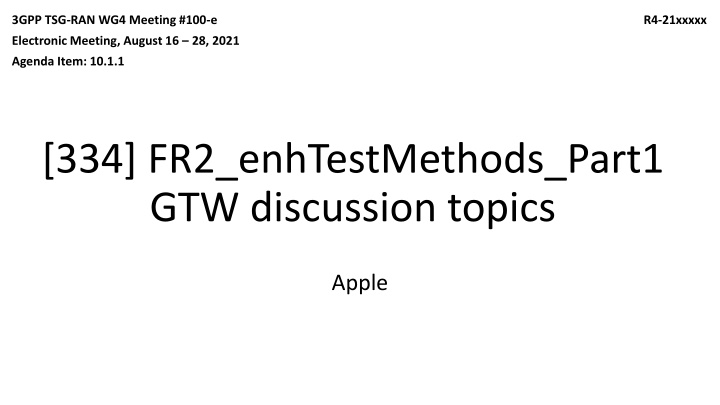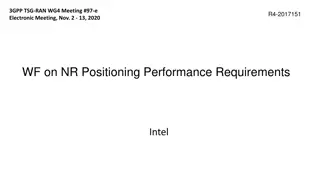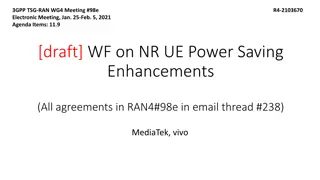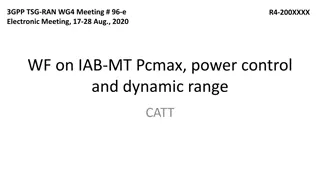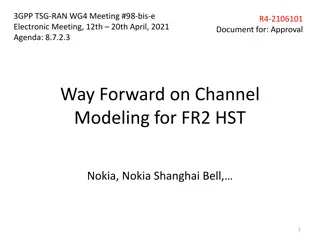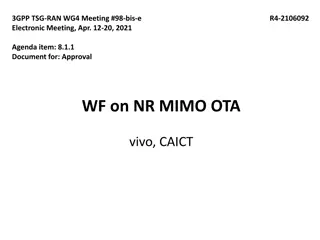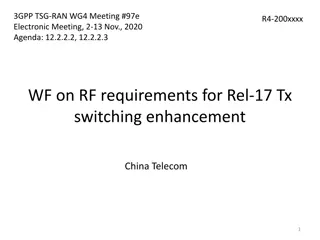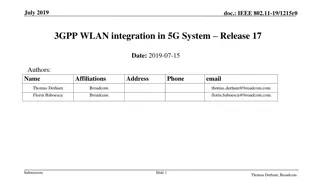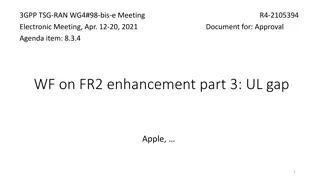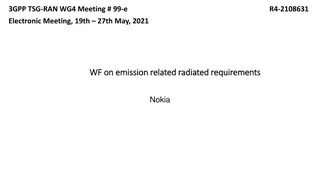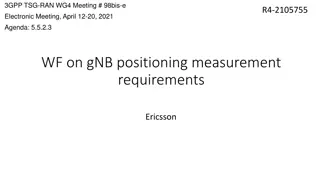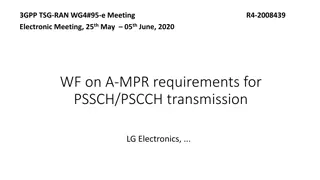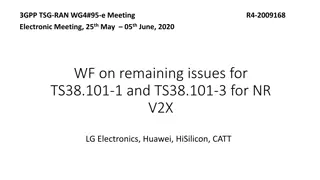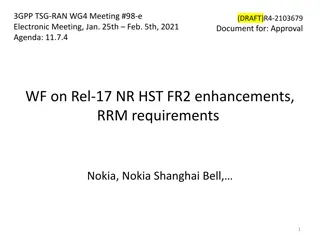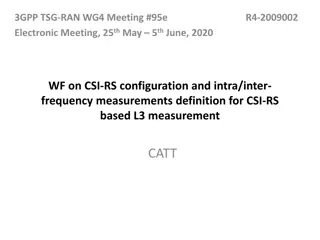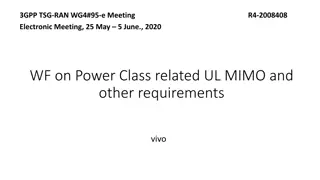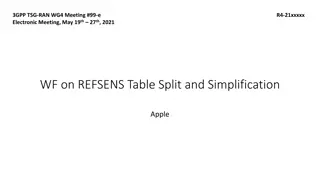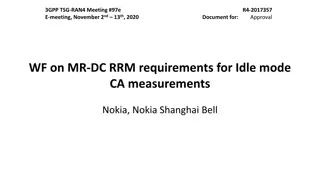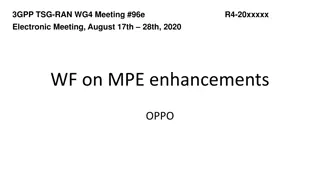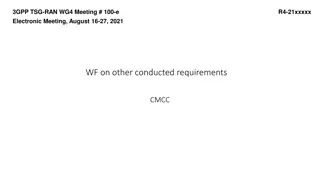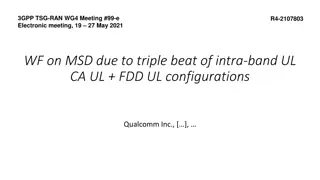Concluding Study of 52GHz Objectives in 3GPP Meeting
The 3GPP.TSG-RAN.WG4 meeting discussed issues related to high DL power and low UL power in the context of CFFDNF methodology. The meeting addressed topics such as black-box approach for CFFDNF, MU assessments, EIRP/EIS measurements, and more. The session aimed to conclude the preliminary MU assessment while considering open issues and new methods for future investigations.
Download Presentation

Please find below an Image/Link to download the presentation.
The content on the website is provided AS IS for your information and personal use only. It may not be sold, licensed, or shared on other websites without obtaining consent from the author.If you encounter any issues during the download, it is possible that the publisher has removed the file from their server.
You are allowed to download the files provided on this website for personal or commercial use, subject to the condition that they are used lawfully. All files are the property of their respective owners.
The content on the website is provided AS IS for your information and personal use only. It may not be sold, licensed, or shared on other websites without obtaining consent from the author.
E N D
Presentation Transcript
3GPP TSG-RAN WG4 Meeting #100-e R4-21xxxxx Electronic Meeting, August 16 28, 2021 Agenda Item: 10.1.1 [334] FR2_enhTestMethods_Part1 GTW discussion topics Apple
Concluding the study of <52 GHz objectives Moderator s general concern: how can we conclude the preliminary MU assessment this meeting, while there are remaining open issues (see Issues 1-1-1, 1-1-2, 1-1-3, 3-1-2, 3-1-3) and even new methods (3-2-1, 3-2-2)? [from the WID]: To ensure timely progress within reduced TUs allocated until RAN #89 (September 2020), objectives 1, 2, and 3 are prioritized until RAN #89. In relation to Objective 7, the studies can start during RAN4 #100 (August 2021). In relation to Objectives 1 through 6, the studies for the frequency range up to 49 GHz are expected to conclude by RAN #93 (September 2021). Proposal for consideration at GTW: Prioritize completion of preliminary MU assessment for methods/elements which have no open issues as of end of this meeting It is up to the RAN4 leadership whether time units can be allocated for further investigations into leftover open issues in future meetings If preliminary MU assessment is not concluded for a particular method/approach, then this method/approach is not considered feasible from the perspective of this study
High DL power and low UL power (2) Issue 1-1-1: Black-box approach for CFFDNF (first round outcome) A local search in DNF, relative to a reference test case, such as peak EIRP at FF and DNF, is necessary to mitigate the effect of the change in antenna pattern as a function of power level/attenuation MU analyses of this approach shall assume that the local search is performed and are expected at the next meeting This relative approach removes 3 out of the 5 MU contributions identified for CFFDNF: DUT antenna location estimation, Probe antenna pattern and Near-field interaction between probe antenna and DUT antenna. Additional MU contributors are FFS. Applicability of correlation factor at reference frequency and relative correlation factor needs to be investigated more Is this tentative agreement acceptable? How to address the FFS parts? How to reconcile MU analysis targeted for the next meeting given the RAN guidance in the WID?
High DL power and low UL power (3) Issue 1-1-2: CFFDNF MU (first round outcome) Consider the min. range length for EIRP/EIS measurements based on the CFFDNF methodology for PC1 devices to be 45cm with an MU for the mean error of 0.5dB (systematic error) [R4-2114384] and specify min range lengths including MU for both CFFDNF and CFFNF for completeness Is this tentative agreement acceptable? Can the outcome be captured in the TR? Can the revised MU assessment be captured in the TR?
High DL power and low UL power (4) Issue 1-1-3: Remaining issues with CFFNF (first round outcome) Revise the following simulation results in the TR: Revise the range length of CFFDNF to r+2 cm in Clause 5.1.4.9 of the TR Use coarse and fine grid search optimizations for CFFNF with black-box approach to reduce total measurement time Include PC1 TRP results for CFFDNF Clarification is required on how the MU due to Influence of Noise on CFFNF approach is to be handled Is this tentative agreement acceptable? Can the outcome be captured in the TR? Can the revised MU assessment be captured in the TR?
Polarization basis mismatch Issue 2-1-1: EVM calculation method for 2L UL Adopt Method 1 as the reference EVM calculation method for FR2 UL MIMO measurements Some companies raised concerns that test equipment vendors need time to upgrade the test system, and it is the common understanding that RAN5 can make use of "transition periods" when they undertake the effort to apply the outcome of this study to the conformance test specification Is this tentative agreement acceptable? Can the outcome be captured in the TR? Can the associated MU assessment be captured in the TR?
Enhancements to reduce test time (1) Issue 3-1-2: RSRP(B) based RX beam peak search (interpretation of reported results) Option 1: only RSRPB is used for beam peak search interpretation based on the following considerations: Without a clear interpretation of how RSRP reporting is implemented for all UEs, only the RSRPB-based test procedure is feasible if RSRPB is confined to being a test function, then only its relative accuracy is important, and it is reasonable to ignore the abosolute reported value based on RSRPB for the purpose of the beam peak search Option 2: both RSRPB and RSRP can be used for beam peak search interpretation based on the following considerations: How the UE's RSRP report is interpreted is according to the following: Option 2a: RSRP is the sum of the RSRPBs for any link pol measurement Option 2b: RSRP is the max of the RSRPBs for any link pol measurement Option 2c: FFS if RSRPB is confined to being a test function, then only its relative accuracy is important, and it is reasonable to ignore the absolute reported value based on RSRPB for the purpose of the beam peak search Moderator s proposal: given the potential need for further investigations related to Option 2, it may be prudent to select Option 1 in order to conclude the study on time
Enhancements to reduce test time (2) The following enhancements are new proposals to this meeting: Issue 3-2-1: Spectrum emission mask test time reduction Proposal: To reduce the test time for FR2 SEM, simplify the test procedure as described in [R4-2114541] Issue 3-2-2: Non-uniform TRP measurement grid for PC1 Proposal: include the non-uniform TRP measurement grid for PC1, as proposed in R4- 2114499, in TR38.884
